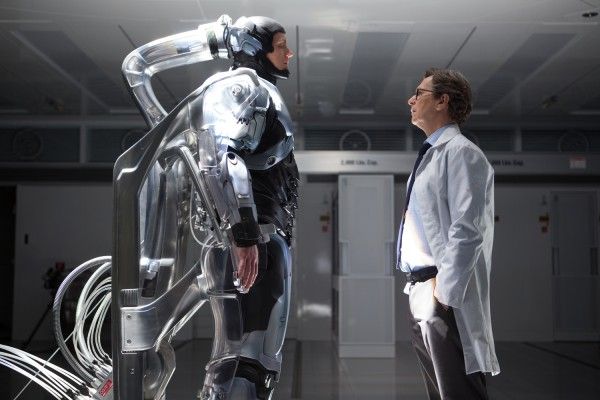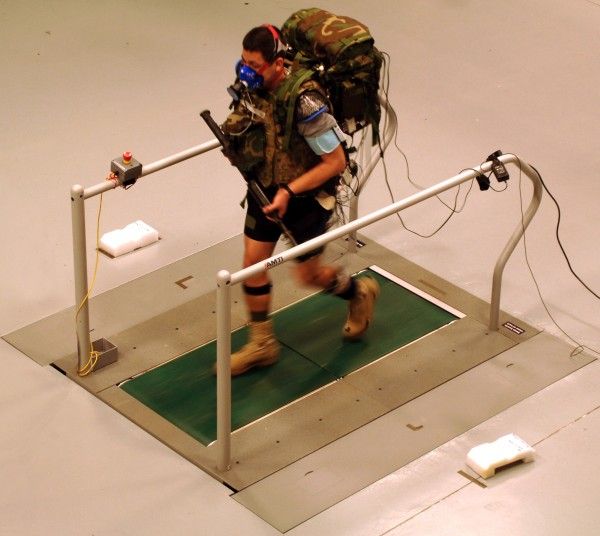José Padilha’s version of RoboCop is more streamlined and tactical than the clunky and heavily armored 1987 original, but are we any closer to seeing this cybernetic technology in reality? Sure, we’ve had almost 30 years of advances in computing, weaponry, communications, surgical techniques, and prosthetics – all necessary fields for creating the cyborg super-soldier – but it’s been the logistical challenge of combining each of these advancements together into one cohesive unit that has proven extraordinarily difficult. So while RoboCop makes it look easy on the big screen this year, hit the jump for a breakdown of just how close (or far away) we are from realizing that technology.
Starring Joel Kinnaman, Abbie Cornish, Gary Oldman, Michael Keaton, Jackie Earle Haley, Michael K. Williams, Jennifer Ehle, Jay Baruchel, Marianne Jean-Baptiste, and Samuel L. Jackson. RoboCop opens in traditional theaters and IMAX on February 12, 2014.
In the year 2028, OmniCorp has already dominated the global market for military machines but wants to bring their technology into Main Street markets. They decide to navigate legal loopholes and get around public sentiment by putting a man inside the machine. There, in a nutshell, is the genesis of RoboCop. While I fully expect the biological and technological advances of 2028 to far out-pace current cutting-edge research in our world, the real challenge is in developing a synergy between organic and inorganic systems. A fully functional cyborg that retains human emotions and cognition would be the pinnacle of this area of research. Let’s take a look at what’s currently available, starting from the head and working our way down.
Heads Up:
Since Alex Murphy was once a physically fit human being before being injured in the line of duty, we’ll not only focus on modern tech and weaponry, but also cutting-edge surgical techniques and regenerative medicines. The head, obviously, contains the nerve center of the body, without which life as we know it ceases to exist. There are ongoing attempts at regrowing neurons in the brain using stem cell grafts and injections with the goal of reversing or stalling neurodegenerative disorders (1),but for the sake of argument, we’ll assume that Murphy’s neurological faculties remain intact. After all, he’ll need them to control his new limbs and process the new form of data coming in through his heads-up display.
The idea of H.U.D.s are nothing new but the technology both built into them and accessible by them is growing increasingly complex and connected (Google Glass, anyone?). In addition to radios and GPS units, today’s modern soldiers possess helmet-mounted cameras that feature satellite connectivity with live feeds to keep HQ apprised of the situation. Some are even equipped with hyperspectral image processing, which tracks people or objects via a unique chemical fingerprint rather than relying on visual confirmation alone.(2) These tools were just a sampling of those used by Navy SEALs on their raid of Bin Laden’s compound, so making the jump from military to domestic law enforcement personnel isn’t that far-fetched at all.
Take Heart:
If the brain is the number-one priority as far as protection is concerned, the heart is a close second. In addition to using the aforementioned stem cells used in regenerative treatments, ongoing research that integrates organic tissue with circuitry has developed “cyborg circuits” that can be grown within organs. These advancements could lead to a sort of internal medical check-up from the circuits within your heart, or even be wired into muscle and bone to grant superhuman strength.(3)
While science is hard at work tinkering away on the inside of the body, the outside needs protection as well, especially in RoboCop’s line of work. In just a few short years, the U.S. Army is expected to roll out a new suit that integrates a number of traits, including nanotechnology and liquid body armor. Named the “Warrior Physiological Status Monitoring System”, this layer of the suit closest to the body contains sensors that monitor physiological indicators (such as heart rate, blood pressure and hydration) and relays the information to medics and field commanders. The body armor is a layer of magnetorheological fluid that turns rigid when an electric pulse is applied. These updates are just a few of those due out in the battlefields of 2020.(4)
Lend a Hand and Get a Leg Up:
One of the first things fans noticed about this new RoboCop is Murphy’s very human hand. The original was all robot from the neck down, but it appears that this version retains more of his organic body than expected. Bionic limbs are further along now than they’ve ever been, but organic regenerative therapies have also come quite a long way. Researchers in the field of prosthetics have started wiring controls for new limbs directly into the nerve endings in muscles left behind after amputations via a “biohybrid bridge” rather than connecting them directly to the brain.(5) While an all-organic BioKnee(6) may be just fine for the common human, if you want a RoboCop, you’ve got to go bionic.
Let’s face it, when we think super-human cyborg, one of the first things that comes to mind is an exoskeleton. You’re not alone, as the U.S. military and D.A.R.P.A. are hard at work on making them a reality. Ideally, the exosuit would increase a soldier’s strength in the field without compromising his mobility. The “Future Force Warrior” suit uses nanomachines in the shoulder that mimic human muscles in order to increase weight-lifting capacity by more than 25%, while an exoskeleton attached to the lower body provides more strength and stability.(4) D.A.R.P.A.’s Warrior Web can be seen in motion below:(7)
Gear Up:
All this talk of regenerative medicine and exoskeletons is great, but what about the weapons of future tech? Well, the great (and scary) thing about modern military weapons is that they’re becoming increasingly communicative, tied into a web of data that makes them deadlier than ever while attempting to minimize collateral damage. A lot of modern weaponry isn’t necessarily tailored to an individual soldier, but rather they’re developed with an eye to overall battlefield efficiency. The trend of minimizing “boots on the ground” in favor of “drones in the sky” is one that points away from the development of a RoboCop-type soldier … but that’s not to say there aren’t some cool new toys out there.
The Navy is expecting to deploy a frickin’ laser on board one of its ships in the Persian Gulf.(8) It’s a bit too big even for RoboCop at present, but who knows, maybe by 2028 it’ll be pocket-sized! The Army is putting emphasis on Cyber Defenders, having graduated the first class of those officers just last month.(9) Again, I don’t expect this to be RoboCop’s bread and butter, but a 21st century cybernetic super-soldier should be able to keep himself virus-free. As far as high-tech weaponry goes, modern S.W.A.T. teams have been using tried-and-true methods for years, with a wide variety of pistols, rifles, shotguns, breaching tools and methods of crowd control at their disposal. It looks like OmniCorp has their own answer to the weapons side of things, so take a look at what they’ll have available in 2028.(10)
When an actual RoboCop will be a reality is anybody’s guess, but the fields of biology and technology are crossing over more than ever these days. Some would say that the next step in human evolution is an entirely artificial one, crafted by our organic minds and implemented alongside our flesh-and-blood systems. I fully expect to see more integration between man and machine as the years go on and our technology gets smaller and smaller while our need to feel connected grows stronger and stronger. Will we ever see a fully realized RoboCop like the ones that appear on screen? Maybe, but we’ll probably see a gradual increase to more tech-integrated human beings first. If we’ve gotten to the point that a RoboCop is needed, then we’ve got much bigger things to worry about.
- 1 – Scientific American, April 2013 “Replanting the Brain’s Forest”
- 2 - http://www.foxnews.com/tech/2011/05/05/5-state-art-military-technologies-helped-bin-laden/
- 3 – Scientific American, June 2013 “Soft Circuits”
- 4 - http://science.howstuffworks.com/ffw1.htm
- 5 – Scientific American, January 2013 “Bionic Connections”
- 6 - http://www.sfexaminer.com/sanfrancisco/biology-trumps-bionics-an-alternative-to-total-knee-replacement/Content?oid=2597307
- 7 - http://www.darpa.mil/NewsEvents/Releases/2013/05/22.aspx
- 8 - http://news.cnet.com/8301-11386_3-57616048-76/military-tech-in-2014-lasers-drones-and-cyberops/
- 9 - http://www.army.mil/article/116564/
- 10 - http://www.omnicorp.com/products/





